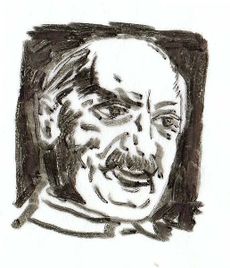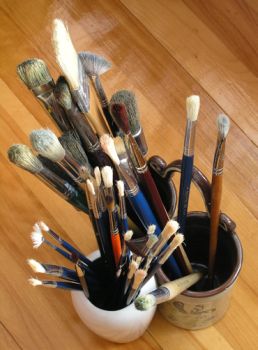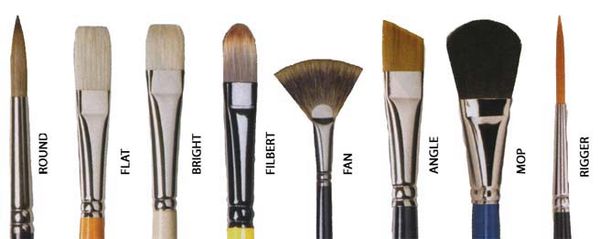Paintbrushes
Paintbrushes

Paintbrushes are used for applying ink or paint. Paintbrushes are primary used by artists for painted pictures. A special kind of drawing is the so-called paintbrush-drawing, drawings are only done with paintbrushes instead of pencil or pen.
These brushes are usually made by clamping the bristles to a handle with a ferrule.
Decorators' brushes
The sizes of brushes used for painting and decorating are given in mm or inches, referring to the width of the head.
Common sizes are:
- ⅛ in, ¼ in, ⅜ in, ½ in, " in, ¾ in, ⅞ in, 1 in, 1¼ in, 1½ in, 2 in, 2½ in, 3 in, 3½ in, 4 in.
- 10 mm, 20 mm, bob 40 mm, 50 mm, 60 mm, 70 mm, 80 mm, 90 mm, 100 mm.
Bristles may be natural or synthetic. If the filaments are synthetic, they could be made of polyester, nylon or a blend of nylon and polyester. Filaments can be hollow or solid and can be tapered or untapered. Brushes with tapered filaments give a smoother finish. [1]
Synthetic filaments last longer than natural bristles. Natural bristles are preferred for oil-based paints and varnishes, while synthetic brushes are better for water-based paints as the bristles do not expand when wetted. [2]
A decorator judges the quality of a brush based on several factors: filament retention, paint pickup, steadiness of paint release, brush marks, drag and precision painting. A chiseled brush permits the painter to cut into tighter corners and paint more precisely. [3]
Handles may be wood or plastic; ferrules are metal (usually nickel-plated steel).
Artists' brushes
Short handled brushes are for watercolor or ink painting while the long handled brushes are for oil or acrylic paint. The styles of brush tip seen most commonly are:
- Round: Long closely arranged bristles for detail
- Flat: For spreading paint quickly and evenly over a surface. They will have longer hairs than their Bright counterpart.
- Bright: Flat brushes with short stiff bristles, good for driving paint into the weave of a canvas in thinner paint applications, as well as thicker painting styles like impasto work.
- Filbert: Flat brushes with domed ends. They allow good coverage and the ability to perform some detail work.
- Fan: For blending broad areas of paint.
- Angle: Like the Filbert, these are versatile and can be applied in both general painting application as well as some detail work.
- Mop: A larger format brush with a rounded edge for broad soft paint application as well as for getting thinner glazes over existing drying layers of paint without damaging lower layers.
- Rigger: Round brushes with longish hairs, traditionally used for painting the rigging in pictures of ships. They are useful for fine lines and are versatile for both oils and watercolors.
Some other styles of brush include:
- Sumi: (Ink and wash painting): Similar in style to certain watercolor brushes,also with a generally thick wooden or bamboo handle and a broad soft hair brush that when wetted should form a fine tip. Also spelled Sumi-e.
- More information is available at [ Wikipedia:Ink and wash painting ]
- Hake: An Asian style of brush with a large broad wooden handle and an extremely fine soft hair used in counterpoint to traditional Sumi brushes for covering large areas. Often made of goat hair.
- Spotter: Round brushes with just a few short bristles. These brushes are commonly used in spotting photographic prints.
- Stencil: A round brush with a flat top used on stencils to ensure the bristled don't get underneath. Also used to create texture.
Artists' brushes are usually given numbered sizes, although there is no exact standard for their physical dimensions.
From smallest to largest, the sizes are:
- 10/0, 7/0 (also written 0000000), 6/0, 5/0, 4/0, 000, 00, 0, 1, 2, 3, 4, 5, 6, 7, 8, 9, 10, 11, 12, 13, 14, 16, 18, 20, 22, 24, 25, 26, 28, 30. Brushes as fine as 30/0 are manufactured by major companies, but are not a common size.
Sizes 000 to 20 are most common.
Artists' brushes are most commonly categorized by type and by shape.
Types include: watercolor brushes which are usually made of sable, synthetic sable or nylon; oil painting brushes which are usually made of sable or bristle; and Acrylic paint brushes which are almost entirely nylon or synthetic. Turpentine or paint thinners used in oil painting can destroy some types of synthetic brushes. However, innovations in synthetic bristle technology have produced solvent resistant synthetic bristles suitable for use in all media. Natural hair, squirrel, badger or sable are used by watercolorists due to their superior ability to absorb and hold water.
Shapes include rounds (pointed), flats, brights (shorter than flats) and filbert. Other shapes include stipplers (short, stubby rounds), deer-foot stipplers, liners (elongated rounds), daggers, scripts (highly elongated rounds), egberts and fans.
Bristles may be natural - either soft hair, pig or hog bristle - or synthetic.
- Soft hair brushes are made from Kolinsky sable or ox hair (sabeline); or more rarely, squirrel, pony, goat, mongoose or badger. Cheaper hair is sometimes called camel hair, although it does not come from camels.
- Hog bristle (often called China bristle or Chungking bristle) is stiffer and stronger than soft hair. It may be bleached or unbleached.
- Synthetic bristles are made of special multi-diameter extruded nylon filament, or Taklon, multi-diameter polyester. and are becoming ever more popular with the development of new water based paints.
Artists' brush handles are commonly wooden but can also be made of molded plastic. Many mass-produced handles are made of unfinished raw wood; better quality handles are of seasoned hardwood. The wood is sealed and lacquered to give the handle a high-gloss, waterproof finish that reduces soiling and swelling.
Metal ferrules may be of aluminum, nickel, copper, or nickel-plated steel. Quill ferrules are also found: these give a different "feel" to the brush.
See also
Chat rooms • What links here • Copyright info • Contact information • Category:Root

